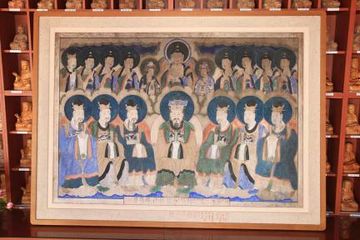김해 영구암 칠성탱
| 김해 영구암 칠성탱 Buddhist Painting of Yeongguam Hermitage, Gimhae (Tejaprabha Buddha and the Seven Stars) |
|
 김해 영구암 칠성탱, 국가문화유산포털, 문화재청. |
|
| 대표명칭 | 김해 영구암 칠성탱 |
|---|---|
| 영문명칭 | Buddhist Painting of Yeongguam Hermitage, Gimhae (Tejaprabha Buddha and the Seven Stars) |
| 한자 | 金海 靈龜庵 七星幀 |
| 주소 | 경상남도 김해시 신어산길 170 (삼방동, 영구암) |
| 지정(등록) 종목 | 경상남도 문화재자료 제504호 |
| 지정(등록)일 | 2010년 10월 7일 |
| 분류 | 유물/불교회화/탱화/불도 |
| 시대 | 대한제국시대 |
| 수량/면적 | 1폭 |
| 웹사이트 | 김해 영구암 칠성탱, 국가문화유산포털, 문화재청. |
|
|
|
해설문
국문
탱화는 천이나 종이에 부처, 보살, 성현들을 그려 벽에 거는 불화이다. 김해 영구암 칠성탱은 일제 강점기에 그려진 탱화이다.
칠성탱은 북극성을 상징하는 치성광여래(熾盛光如來)와 북두칠성을 상징하는 칠성여래(七星如來)를 그린 것이다. 북극성과 북두칠성은 사람의 수명을 연장해 주는 역할을 한다고 하여 주로 장수를 기원하는 용도로 제작된다. 불교 사찰에서는 칠성신을 모시는 칠성각을 따로 지어 그 곳에 칠성탱을 둔다. 이러한 신앙은 도교에서 시작된 것을 불교에서 흡수하여 이어 나간 것이다.
탱화 중앙에는 북극성을 상징하는 치성광여래가, 좌우에는 해와 달을 상징하는 일광보살과 월광보살이 위치한다. 일광보살의 왼쪽과 월광보살의 오른쪽에는 북두칠성을 상징하는 칠성여래가 서 있다. 왼쪽 끝에는 도교에서 북극성에 해당하는 자미대제가 자리하고, 치성광여래 아래에는 도교에서 북두칠성에 해당하는 칠원성군이 앉아 있다.
탱화의 제작 경위를 적은 글을 보아, 영구암 칠성탱은 부산·경남 지역에서 불화를 그리는 스님으로 활약한 낙현 스님의 초기 작품임을 알 수 있다.
영문
Buddhist Painting of Yeongguam Hermitage, Gimhae (Tejaprabha Buddha and the Seven Stars)
This painting depicts Tejaprabha (Buddha of Polaris) and the divinities of the Seven Stars of the Big Dipper (known as Chilseong in Korean). It was painted in 1910 by the painter-monk Nakhyeon (1869-1933), who lived mainly in Busan and the Gyeongsang-do region.
Since Tejaprabha and the Seven Stars were both believed to control longevity and prosperity, this type of Buddhist painting was usually made to pray for longevity. Chilseonggak Shrine, where the Seven Stars are venerated, is only found at Korean Buddhist temples and is an example of Korean Buddhism’s integration of local folk beliefs and practices.
The painting depicts 18 figures arranged in two rows. In the upper row, Tejaprabha is depicted in the center, flanked by Candraprabha (Bodhisattva of Moonlight) and Suryaprabha (Bodhisattva of Sunlight) on his left and right, respectively. To either side of the bodhisattvas are the Buddhas of the Seven Stars, with the Great Emperor of the North Pole, a Daoist deity, at the far left. In the lower row, the Daoist divinities of the Seven Stars are depicted seated. At the bottom of the painting, there is an written inscription which includes when, by whom, and with whose financial support the painting was made.
영문 해설 내용
이 불화는 북극성을 상징하는 치성광여래와 북두칠성을 상징하는 칠성여래를 그린 것이다. 부산, 경상남도 일대에서 활동했던 승려 화가인 낙현(1869-1933)이 1910년에 그렸다.
북극성과 북두칠성은 사람의 수명을 관장한다고 여겨졌기 때문에, 이러한 불화는 주로 장수를 기원하기 위해 제작되었다. 한국의 불교 사찰에서는 칠성신을 모시는 칠성각을 따로 짓고 칠성탱을 모셨다. 이는 한국 불교가 민간신앙과 융합하여 발전했음을 보여주는 특징이다.
그림에는 총 18명의 인물들이 두 줄로 배치되어 있다. 윗줄 중앙에는 치성광여래가 있고, 왼쪽과 오른쪽에는 각각 달과 해를 상징하는 월광보살과 일광보살이 있다. 두 보살 옆에는 칠성여래가 있고, 왼쪽 맨끝에는 도교에서 북극성을 상징하는 자미대제를 두었다. 아랫줄에는 도교에서 북두칠성을 상징하는 칠원성군이 앉아 있다. 화면 아래쪽 중앙에는 작가의 이름, 제작 시기, 후원자들의 이름이 적혀 있다.
참고자료
- 김석곤,월주문파의 불교회화연구 (RISS), 동국대학교 박사학위 논문, 2019.
- 김해 영구암 삼층석탑, Pleasure from Emptiness, 다음 블로그 https://blog.daum.net/hanulh/1124 -> 탱화 구도 설명 쉬움
- 화재·파괴서 살아남은 탱화·석탑… “거북이 모양 암자 영험 덕인가” (7)영구암 삼층석탑·칠성탱화, 김해뉴스, 2017.4.12. http://www.gimhaenews.co.kr/news/articleView.html?idxno=18172 -> 칠성탱화는 완호 낙현스님(1869~1933)이 1910년에 그린 작품이다. 작품 아래쪽에는 작가의 이름과 제작 시기, 후원자들의 이름이 적혀 있다. 그림의 보존처리 과정에서 나온 복장물에도 이같은 사실이 분명하게 드러나 있다. 담백한 색채를 사용하면서도 명암을 달리해 그림에 깊이를 부여한 게 특징이다. 영구암 관계자에 따르면, 처음에는 칠성탱화가 그렇게 귀중한 자료인지 몰랐다고 한다. 선공 스님은 "원래는 탱화의 상당 부분이 금박으로 돼 있었다. 지금도 자세히 보면 탱화 곳곳에 금박이 남아 있다. 탱화가 있던 삼성각이 습한데다 작품이 100여 년 전의 것이다 보니 자연스럽게 훼손됐다. 추가 훼손을 막기 위해 4~5년 전 영구암 입구 칠성각으로 그림을 옮겼다"고 설명했다.